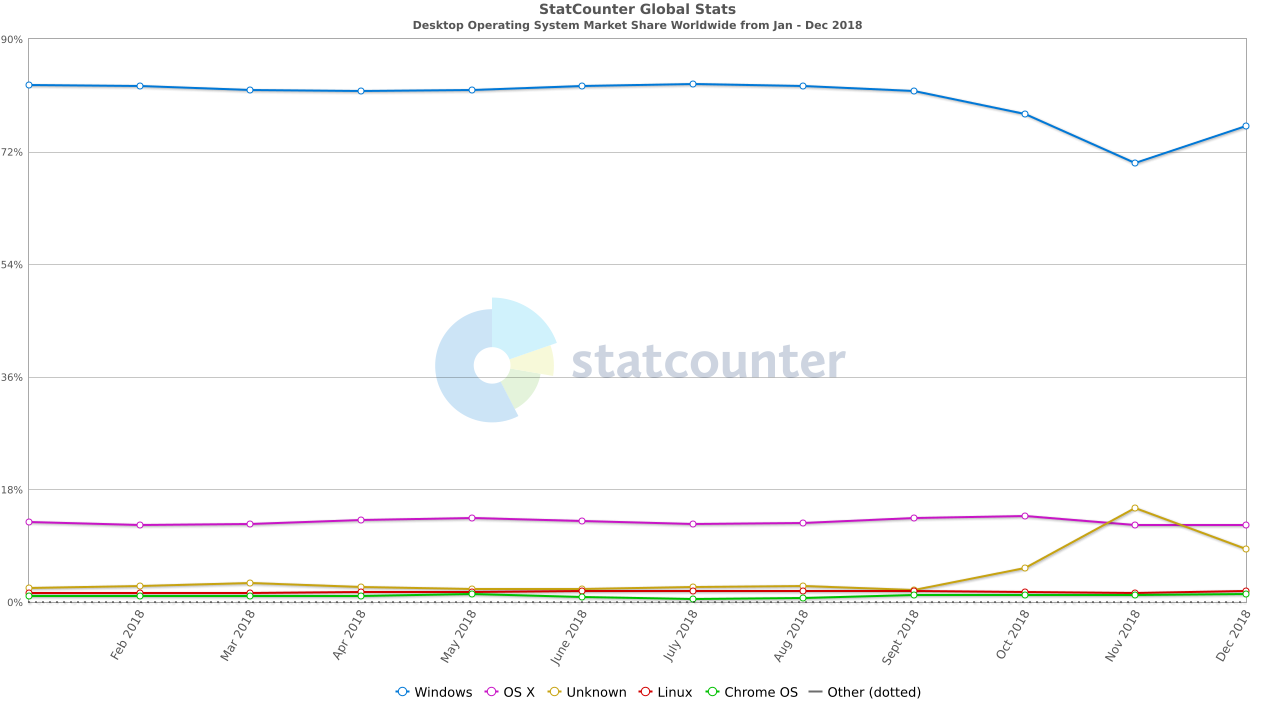Linux Hits All-Time High of 3% of Desktop PC Share After 30 Years
Linux achieves its highest market share ever.

While Linux has several advantages over Apple's Mac and Microsoft's Windows, it has never really gained any traction in PCs. After 30 years on the market, the open-source operating system has achieved 3% of desktop PC OS market share, reports Linuxiac citing StatCounter, marking an all-time high.
Currently, Windows commands 68.15% of the PC market share, MacOS occupies 21.38%, Chrome OS has 4.15%, and Linux is used on 3.08% of PCs. Around 3.24% of all systems run either FreeBSD or an unknown operating system, which are most likely either very new or very old versions of popular OSes.
Based on data from StatCounter, Linux's share doubled from 1.64% in 2018 to around 3% in 2023. On the other hand, MacOS increased its share from 12.33% in 2018 to 21.38% today, whereas the share of Windows dropped from around 82% five years ago to 68.15% today.

But while Linux is barely used on desktop PCs, it dominates servers, supercomputers, edge systems, IoT, and embedded PC markets due to the versatility, security, and open-source nature of the OS, which allows developers to quickly innovate.
But desktops and notebooks do not necessarily benefit from the same things as servers or NAS. Users are way too familiar with Windows and MacOS to switch to Linux, which is why the operating system has remained a distant outsider on the market of consumer PCs. Nonetheless, its market share is slowly growing, though it is hard to make predictions about whether the OS is set to gain any further traction.
Perhaps the popularity of devices like Steam Deck will make Linux more accepted by gamers, and from there, its adoption on desktops and notebooks will grow, too. But for now, Linux remains a niche OS for consumer PCs.
Get Tom's Hardware's best news and in-depth reviews, straight to your inbox.

Anton Shilov is a contributing writer at Tom’s Hardware. Over the past couple of decades, he has covered everything from CPUs and GPUs to supercomputers and from modern process technologies and latest fab tools to high-tech industry trends.
-
RichardtST Perfect timing too. Totally my fault. I just installed a linux mint openvpn server yesterday. Using it for remote work even as I'm writing this comment... :)Reply -
cknobman Wonder if Steam Deck contributed to this figure.Reply
Also if Windows 12 (or whatever the call it) rumors are accurate of Microsoft moving to a streaming model where we are basically using VM's in the cloud, I bet Linux use will explode.
I know I will ditch Windows in a heartbeat if that happens. -
Dr3ams If Linux could gain the full support of proprietary application and game publishers, then I would seriously consider switching. For now, I'll have to settle for running it in a virtual machine.Reply -
ezst036 This is the Steam effect. Linux has really needed some major/visible OEM to pick up Linux as their first-tier OS. The Steam Deck was just that visible item.Reply
It took 5 years to double the Linux share from 2018. It'll take less than that time to double it again.
Honestly though, the bigger news is that MacOS has now over 20%. At this rate of growth, Apple could begin to start looking like a Windows replacement in a relatively short time.
The big loser, of course, is Microsoft. No wonder they're desperate to take over Activision/Blizzard. -
PlaneInTheSky This is the typical fake news article I despise, where the article is technically correct, but incredibly manipulative and clickbaitey.Reply
I pulled up the desktop data and added the percentages in an image. (0.04% was rounded down, 0.05% rounded up)
This is what the stats show.
1) Linux usage in the US has DROPPED in the last 6 months, to 1.9%, down from 2.7% at the start of the year. It's a significant drop in 6 months and the lowest it has been in one and a half years.
2) Linux usage has been "STABLE" worldwide. It is now at 3.07% on desktop, about where it was at the start of the year where it hit 2.93%. You can call that a "record", it would be more fair to call that 0.14% change a rounding error.
-
Friesiansam Depending on what direction MS takes Windows over the next few years, I may well be adding to that 3%.Reply -
hotaru.hino I think it's also important to note how Statcounter gathers its data: https://gs.statcounter.com/faq#methodology. The gist is they use tracking code that web sites can embed. Depending on how the user's browser is set up, if the computer is even connected to the internet at all, or the user somehow avoids those websites, this code may or may not be executed.Reply
For instance, claiming that macOS has a 20% market share is odd considering that a quick Google search tells me that Apple only shipped ~7 million computers last year (https://www.statista.com/statistics/263444/sales-of-apple-mac-computers-since-first-quarter-2006/) , which is near as much as they've ever shipped in a year. Meanwhile about 286 million "Personal computers" were shipped last year (https://www.statista.com/statistics/273495/global-shipments-of-personal-computers-since-2006/) -
hotaru.hino Reply
While I see some services becoming subscription based, I doubt the core OS and updates will become subscription based.Zerk2012 said:If / when Windows moves to a subscription I will be joining that 3%
Besides they don't really need to do that. They just need to add some requirement that makes people buy new hardware sooner than they'd like.
